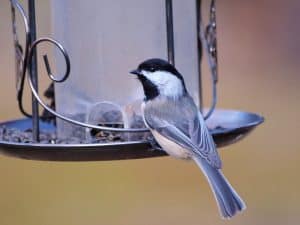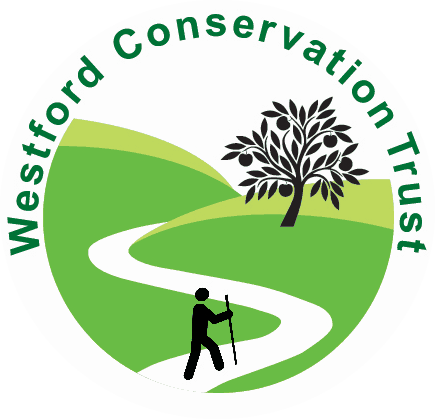
Do you have a large glass window or slider at your house? If so, chances are you have seen a bird strike that glass at some time. If the bird is lucky, it will just stun itself, perhaps need a few minutes to “come to” and then fly off. Sometimes, though, the bird is killed by the window strike. Living Bird, a publication of the Cornell Lab of Ornithology, reported on this problem in an article titled “Glass Action for Birds”, in its winter 2014 edition. It has been estimated that up to a billion birds are killed each year by window collisions in the United States alone.
Scott Loss of Oklahoma State University has done bird strike research for the Smithsonian Conservation Biology Institute and the U.S. Fish and Wildlife Service. He found, surprisingly, that the majority of annual bird deaths occur at residential and low-rise structures. The average family residence kills one to three birds a year. Loss found that six species seem to die of glass strikes most commonly: Ruby-throated hummingbirds, brown creepers, ovenbirds, yellow-bellied sapsuckers, gray catbirds, and black and white warblers. It seems that these long-distance migrants may be less familiar with the structures in areas they pass through on migration. I notice that at my house, however, the birds mostly likely to strike the glass are mourning doves, downy woodpeckers, chickadees and titmice. It seems that they do this when they are flying in panic to avoid a hawk predator.
Daniel Klem a Muhlenberg College professor has been studying what works to help birds avoid collisions with glass. He found that birds, like people, do not see glass and do not recognize the structural clues people use, such as window frames and building walls. Glass can act as a mirror reflecting the sky and vegetation. New UV windows or windows with dot arrays have been found to be only moderately effective. Klem finds that windows with vertical stripes spaced four inches apart or horizontal stripes spaced two inches apart on the outside of the glass work best. Stripes should be at least 1/4″ wide and light colors are better than dark colors.
What can we do at home? Cornell Lab suggests keeping feeders a foot or less away from windows, so birds that fly away from feeders cannot gain enough speed to hit the glass. Apply paint or decals, hanging strings, soap or tape in vertical rows four inches apart or horizontal rows two inches apart, on the outside of the window. Decals on the inside may be invisible because of the reflections on the window. You can use any decals placed in lines, even holiday shapes. Fine netting placed over windows or regular window screens inside the window should also work. For more information go to the American Bird Conservatory website, http://tinyurl.com/birdwindows. This site has some great photos of ways you can effectively treat your windows, and some suggests some places to buy materials.
Many thanks to all flora and fauna reporters for the month of August. Please send reports by September 26 for next month’s column. You can call me at 692-3907, write me at 10 Chamberlain Rd., or e-mail me at mariancharman@verizon.net.
Late July Reports:
Dot Mooney, Monadnock Dr. July 19, chipping sparrows, flicker, goldfinch, house finch and downies around early morning. At 8:45 p.m., one bat swooping about over back lawn. July 22, listening to a catbird in the woods early morning. Hearing him, with his wide range of calls, you would think there was a group of all different kinds of birds gathered together–love these catbirds. Male cardinal on feeder. Queen Anne’s lace blooming around sumacs, many interesting mushrooms by edge of front woods. July 25, three little downies still arguing over suet, as they have all summer. Now a fourth downy has arrived on deck. He seems a bit timid, not approaching suet. July 26, sitting out front, I saw a pretty eastern swallowtail butterfly visiting various potted plants. Watched a chipping sparrow sipping from bird bath. Two titmice hopped in and both enjoyed noisy baths. July 27 noon, at Howard Rd. wetland, saw what appeared to be a little short-tailed weasel hurrying across the road and down toward the water. Growing in the water, water hemlock, an extremely poisonous plant which looks like Queen Anne’s lace. Monadnock Dr. evening, one blue jay parent feeding suet to two begging youngsters. Five downy woodpeckers on deck. July 28, under Parkhurst power lines, peppergrass, ragweed, rabbit’s foot clover, spotted knapweed, Queen Anne’s lace. Heard a towhee repeating his “Drink your tea” call. Pretty little hummer visiting my potted plants on deck. Female red-bellied woodpecker on suet and a little downy watching. July 30, purple loosestrife appearing here and there in wetlands, but not huge areas of it as I used to see. July 31, many small bumblebees around my potted plants, especially at the zinnias. Many flowers are in their best high summer bloom now. Cicada calling from high in a tree out front, others calling from all directions. A row of sumacs along back wood, not poisonous, their seed heads getting darker red every day. Birds will enjoy them later in the winter when food is scarce.
Diane Duane, Howard Rd. July 22, two monarch butterflies during the water chestnut pull in our kayaks on Stony Brook near the Stepinski well area. Also a beautiful white admiral butterfly in the same area, with some swamp milkweed. What a beautiful area to kayak!
August Reports:
Dot Mooney, Monadnock Dr. August 1, Another nice day in the 80’s. Stopped by Howard Rd. wetland. Numerous painted turtles of various sizes in water, mostly floating with heads above water. Loud truck went by and heads all disappeared for a moment, then promptly all popped up again. At some point many turtles began wandering around all over the water, staying close to water plants. Some purple loosestrife by edge of water, a few violet blue pickerelweed flowers blooming. Pleasant little wetland. August 2, a red-eyed vireo repeating his call out back. August 5, little house wren poking around forsythia. August 9, watched one chimney swift flying around over building and back woods. A turkey vulture over woods, two titmice bathing together, a female house finches hopped in as soon as titmice life. August 10, stopped by a field on Hildreth St., heard an Eastern wood peewee nearby. At Howard Rd. wetland, many turtles, small bumblebees on last blossoms of flowers, a huge blue-black wasp around, dragonflies everywhere. Under power lines in Hildreth Hills, saw late goldenrods, spotted knapweed, common St. John’s-wort, rabbits foot clover all puffed out and pink, so soft to the touch. August 11, noticed a beautiful cooper’s hawk perched on a large boulder near bird feeder, just looping around after a failed attempt. He then flew to a tree for a better look. Forty-five minutes later the hawk flew out of the tree and disappeared. August 15, a saucy hummer visited plants on deck, took a moment to closely buzz around a downy, who kept ducking his head. August 16, Howard Rd. wetland, at least fourteen turtles of various sizes. Pretty purple-topped grasses by the side of the road. On pond side of Beaver Brook, two adult swans drifting about with their two grey and one white youngsters, a mallard family in the distance. On brook side, at edge of or in the water, buttonbush, pickerelweed, yellow pond lily and white fragrant water lily. Under Hildreth Hills power lines, heard chattering goldfinches, one catbird on shrub. Many shrubs and vines all showing early color changes, goldenrods beautiful. Green acorns of all sizes in caps, scattered about on ground. Titmice taking baths out front, then they head to feeder for some snacks. August 18, opened a window after dark and was delighted to hear the loud chorus of summer night insects, in full voices, competing to be heard. “Len told me some of the warblers have already begun to migrate south. After hearing that and seeing vines and shrubs showing early colors, I had better enjoy every lovely day that we are allowed to have….This has been a lovely summer, no big drought so everything green and pretty. I’ve enjoyed it all.”
Marian/Bill Harman, Chamberlain Rd. August 6, Carolina wrens are feeding babies on our screened porch again. They come in and out through a hole in the screen. Two juvenile barred owls calling. We could see them well when we briefly shone a flashlight on the branch they were sitting on. August 15, two baby Carolina wrens fledged from the nest on our porch today. August 17, two beautiful spotted fawns walked in the grass along our driveway towards the street. When a car went by, they turned and bounded into the pasture. A walk at Lakeside Meadows and Shipley Swamp. Birds: Crow, goldfinches, pee-wee in the woods, catbird, at least ten cedar waxwings in the field eating bugs or seeds. Plants seen: maiden pink, cattails, purple loosestrife, prostrate tick trefoil, Indian pipes, showy tick trefoil, spotted knapweed, white water lily, goldenrod, Queen Anne’s lace, yarrow, common tansy. Also seen, two tiger swallowtail butterflies feeding on milkweed, baby bunny.
Marilyn Day, Graniteville Rd. August 12. A coyote loping across the front yard at 12:10 p.m.
Diane Duane, Howard Rd. August 14, a beautiful monarch in our front garden on common milkweed. It looks like she laid eggs and we see at least one on a leaf [Diane sent a great photo-MH].
Rosemarie Koester, Providence Rd. August Report: titmice, chickadees, nuthatch, two pairs of blue jays, red-winged blackbirds, some grackles, balding on the blue jays. Two pairs of cardinals, one juvenile, downy woodpecker, red-bellied woodpecker, several house finches, goldfinches. Chickadees seem to like the goldfinch feeder, hawk circling overhead, wren on deck. A bird nest in between the gutter guards in front of house, hummingbirds very active at feeder, but dropped off considerably last week. I didn’t notice any change in bird behavior during the eclipse of the sun., a few turkeys around. Also, four gray squirrels, one red squirrel fussing at the gray squirrel, several chipmunks, lots of rabbits, young as well, enjoying my flowers. A deer with fawn in the woods. Good to see a fair number of bumble bees at flowers. August 25, a blue-spotted salamander was under a flower pot I removed! I put pot back so maybe it will return. [Rosemarie sent a good photo of this rare salamander-MH] Many thanks to those who are removing the invasive vines around town. But, still see much bittersweet climbing on trees, bushes around town. This will destroy the tree if not removed.
Marian Harman is a member of the Westford Conservation Trust, a non-profit conservation organization whose purpose is the preservation of Westford’s open spaces and trails. The Trust welcomes new members and volunteers.
